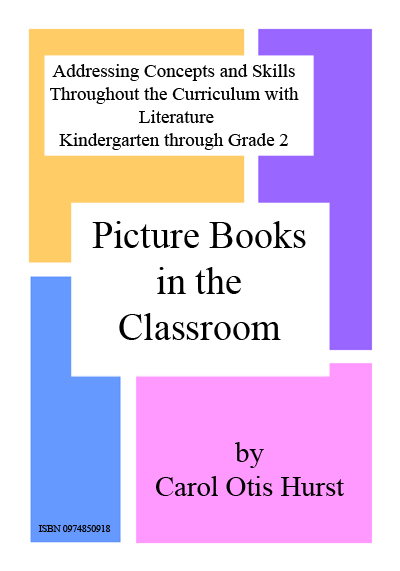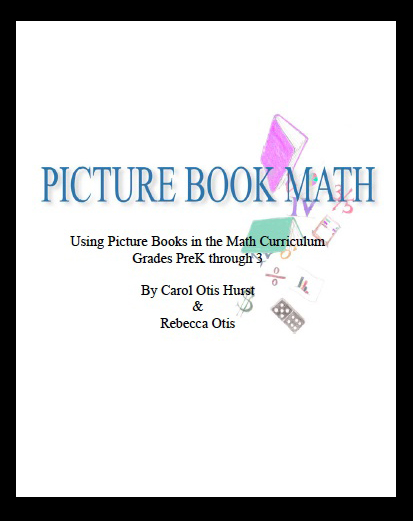Carol Hurst's Children's Literature Site
Newsletter, Volume 18, Issue 2
![]()
Fairy Tales and Folk Tales for Grades Preschool through Ninth Grade
Picture Books, Short Stories, Novels, Poems and Anthologies with Classroom Activities
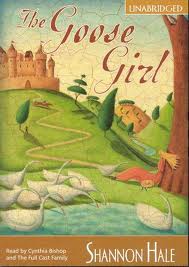 Investigating folklore is a way of bringing out literary figures and traditional rhymes to which the children are going to hear allusions all their lives. Since much of it is not passed on from generation to generation the way it was in earlier times, this classroom topic offers a way for students to gain the important background and enjoy some wonderful writing and illustrating along the way.
Investigating folklore is a way of bringing out literary figures and traditional rhymes to which the children are going to hear allusions all their lives. Since much of it is not passed on from generation to generation the way it was in earlier times, this classroom topic offers a way for students to gain the important background and enjoy some wonderful writing and illustrating along the way.
Folklore is also an excellent subject for developing analytical and comparative literature skills for students of all ages. Explore different cultures around the world and their history by reading their traditional tales. Find plot and character templates for creative writing in any of the wonderful books below. In short, some of the world's oldest stories belong throughout your curriculum.
![]()
Please visit our advertisers who make this newsletter possible:
![]()
|
|
Traditional Folk and Fairy Tales
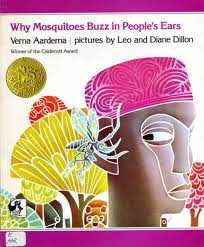 Why Mosquitoes Buzz in People's Ears by Verna Aardema. Illustrated by Leo and Diane Dillon. (1975, Dial. ISBN 0803760892.) Picture Book. 32 pages. Gr K-3.
Why Mosquitoes Buzz in People's Ears by Verna Aardema. Illustrated by Leo and Diane Dillon. (1975, Dial. ISBN 0803760892.) Picture Book. 32 pages. Gr K-3.
Find this book: Local Bookstore, Amazon, B&N
This Caldecott award winning African tale uses the cumulative format. It happened this way: a mosquito said something foolish to the iguana who put sticks in his ears so that he would hear no more such foolishness. This frightened the next animal who saw the iguana and so on. As the animals explain the sequence of events, one part of the illustration shows what they think happened while another part shows what really happened. Read More.
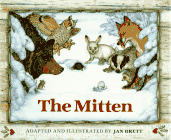 The Mitten by Jan Brett. (1989, Putnam. ISBN 039921920X.) Picture Book. 32 pages. Gr PreK-2.
The Mitten by Jan Brett. (1989, Putnam. ISBN 039921920X.) Picture Book. 32 pages. Gr PreK-2.
Find this book: Local Bookstore, Amazon, B&N
Jan Brett has put her own spin on the familiar folk theme of a shelter that stretches to accommodate each new occupant. Here, based on a Ukrainian tale, it's a boy, Nicki, who begs his grandmother, Baba, to knit him a pair of white mittens. A mole discovers the mitten lying on the snow and crawls inside, followed by a snowshoe rabbit, a hedgehog, an owl, a badger, a fox, a bear, and finally a mouse. Read More in our Featured Book article including classroom activities, related books and links.
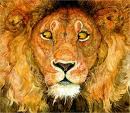 The Lion and the Mouse by Jerry Pinkney. (2009, Little, Brown. ISBN 9780316013567.) Wordless Picture Book. 40 pages. Gr PreK-3.
The Lion and the Mouse by Jerry Pinkney. (2009, Little, Brown. ISBN 9780316013567.) Wordless Picture Book. 40 pages. Gr PreK-3.
Find this book: Local Bookstore, Amazon, B&N
This wordless Aesop fable is gorgeous. We are surprised when the lion frees the mouse he has caught and then touched when mouse finds a surprising way to return the favor. The cover of the book fittingly is absent of any title or other print to set the silent nature of a wordless book from the very beginning. A great retelling of a classic for a new generation. Winner of the 2010 Caldecott Medal.
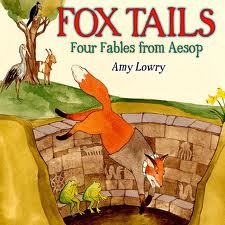 Fox Tails: Four Fables from Aesop by Amy Lowry. (2012, Holiday House. ISBN 9780823424009.) Picture Book. 32 pages. Gr K-4.
Fox Tails: Four Fables from Aesop by Amy Lowry. (2012, Holiday House. ISBN 9780823424009.) Picture Book. 32 pages. Gr K-4.
Find this book: Local Bookstore, Amazon, B&N
Four fables, all featuring a fox, have been combined into one story. "The Fox and the Grapes" (of sour grapes fame), "The Fox and the Crow," "The Fox and the Goat," and "The Fox and the Stork" all star a trickster fox, but, in the end, the tables are turned. Lowry has illustrated the story with gentle, clean drawings which reward closer inspection with hidden details. This is a subtly humorous, satisfying read.
 Seven Blind Mice by Ed Young. (1992, Philomel. ISBN 9780399222610.) Picture Book. 48 pages. Gr K-5.
Seven Blind Mice by Ed Young. (1992, Philomel. ISBN 9780399222610.) Picture Book. 48 pages. Gr K-5.
Find this book: Local Bookstore, Amazon, B&N
In this startlingly illustrated version of "The Blind Man and the Elephant," seven blind mice go, one by one, to identify a large object. Each perceives one part of it and pronounces it to be something. It is only the white mouse who combines all the colors of the others who sees the elephant.
 Lon Po Po: A Red-Riding Hood Story from China by Ed Young. (1989, Philomel. ISBN 9780399216190.) Picture Book. 32 pages. Gr 2-9.
Lon Po Po: A Red-Riding Hood Story from China by Ed Young. (1989, Philomel. ISBN 9780399216190.) Picture Book. 32 pages. Gr 2-9.
Find this book: Local Bookstore, Amazon, B&N
This tale from China is a version of Little Red Riding Hood. A mother leaves her three daughters while she visits their granny. While she's gone a wolf comes to their door disguised as their granny. It's the illustrations that bring this book to a high level. Young uses panels which echo Chinese decorative screens as well as full page spreads on which the image of the wolf is sometimes subtle but ubiquitous. It won the Caldecott Medal. We highly recommend it.
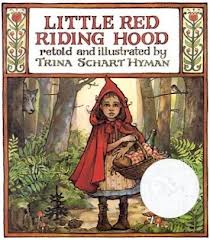 Little Red Riding Hood by Trina Schart Hyman. (1982, Holiday. ISBN 978-0823404704.) Picture Book. 32 pages. Gr PreK-4.
Little Red Riding Hood by Trina Schart Hyman. (1982, Holiday. ISBN 978-0823404704.) Picture Book. 32 pages. Gr PreK-4.
Find this book: Local Bookstore, Amazon, B&N
This book was a Caldecott Honor Book for 1984 and it is gorgeously illustrated. The retelling of the story is also solid. Curl up with your favorite child or group of children for an intimate reading of this spooky story. The illustrations are also a great inspiration for young artists.
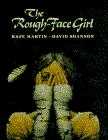 The Rough-Face Girl by Rafe Martin. Illustrated by David Shannon. (1992, Putnam. ISBN 9780399218590.) Picture Book. 32 pages. Gr 2-5.
The Rough-Face Girl by Rafe Martin. Illustrated by David Shannon. (1992, Putnam. ISBN 9780399218590.) Picture Book. 32 pages. Gr 2-5.
Find this book: Local Bookstore, Amazon, B&N
This is an Algonquin Native American Cinderella story in which the "prince" is an invisible being who will only marry a woman who can see him. The youngest, abused daughter of a poor man sees and describes him after her older proud sisters fail.
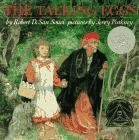 The Talking Eggs: A Folktale from the American South by Robert D. San Souci. Illustrated by Jerry Pinkney. (1989, Dial. ISBN 9780803706194.) Picture Book. 32 pages. Gr 3-6.
The Talking Eggs: A Folktale from the American South by Robert D. San Souci. Illustrated by Jerry Pinkney. (1989, Dial. ISBN 9780803706194.) Picture Book. 32 pages. Gr 3-6.
Find this book: Local Bookstore, Amazon, B&N
This Creole folk tale is retold in the milieu of the 19th century South. It tells of a mother and her daughter, Rose who mistreats her other daughter Blanche. In Cinderella style she is befriended by a old woman who demands respect in spite of bizarre doings. As a reward, Blanche is given talking eggs which open to reveal great treasures.
Her Stories: African American Folktales, Fairy Tales, and True Tales by Virginia Hamilton. Illustrated by Leo & Diane Dillon. (1995, Blue Sky. ISBN 9780590473705.) Short Stories. 128 pages. Gr 2-8.
Find this book: Local Bookstore, Amazon, B&N
The stories here all involve females but cover a wide range of genres and types. Some are true accounts of ex-slaves, others are folk and fairy tales. Some are humorous and some downright scary. Extensive source notes provide background information on the tales and the acrylic illustrations by the Dillons vividly enhance the stories.
Princess Furball by Charlotte Huck. Illustrated by Anita Lobel. (1994, Greenwillow. ISBN 9780688131074.) Picture Book. 40 pages. Gr 2-5.
Find this book: Local Bookstore, Amazon, B&N
The Cinderella tale is ubiquitous and has countless variations. Charlotte Huck has combined efforts with Anita Lobel to give us one of the tale’s lesser known variants. This is the tale of a king’s cruel decision to marry off a princess to an ogre and her escape, recapture, and eventual fate. Ms Huck tells the story with directness and charm which is echoed in Anita Lobel’s artistry. It’s a welcome addition to any folklore unit.
The Egyptian Cinderella by Shirley Climo. Illustrated by Ruth Heller. (1989, HarperCollins. ISBN 9780690048223.) Picture Book. 32 pages. Gr 1-5.
Find this book: Local Bookstore, Amazon, B&N
The Cinderella character is Rhodopis, an Egyptian slave, taunted and tormented by three Egyptian servant girls. The prince is a pharaoh, who is given Rhodopis' golden slipper by a falcon.
Snow White and the Seven Dwarfs by Randall Jarrell. Illustrated by Nancy Ekholm Burkert. (1987, Turtleback. ISBN 9780833599056.) Picture Book. 32 pages. Gr 2-6.
Find this book: Local Bookstore, Amazon, B&N
The illustrations are so delicate that they appear fragile. The setting is suitably medieval and every detail is perfect. If your students know only Disney's rendition, they deserve this one.
Yummy: Eight Favorite Fairy Tales by Lucy Cousins. (2009, Candlewick. ISBN 9780763644741.) Short Story Anthology. 128 pages. Gr PreK-2.
Find this book: Local Bookstore, Amazon, B&N
Classic Fairy Tales by Berlie Doherty. Illustrated by Jane Ray. (2009, Candlewick. ISBN 9780763642129.) Short Stories. 224 pages. Gr K-3.
Find this book: Local Bookstore, Amazon, B&N
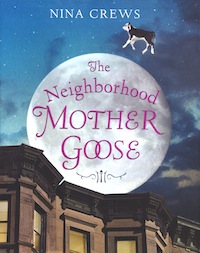 The Neighborhood Mother Goose by Nina Crews. (2004, Greenwillow. ISBN 9780060515737.) Poetry. 63 pages. Gr PreK-2.
The Neighborhood Mother Goose by Nina Crews. (2004, Greenwillow. ISBN 9780060515737.) Poetry. 63 pages. Gr PreK-2.
Find this book: Local Bookstore, Amazon, B&N
Nina Crews has put traditional nursery rhymes in a contemporary urban setting by accompanying them with photographs and computer manipulated photographs of Brooklyn, New York. A large modern city changes the quaint tone of some volumes into something more immediate. Kids will like the creativity and playfulness of these interpretations.
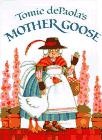 Tomie dePaola's Mother Goose by Tomie dePaola. (1985, Putnam. ISBN 9780399212581.) Poetry. 128 pages. Gr PreK-2.
Tomie dePaola's Mother Goose by Tomie dePaola. (1985, Putnam. ISBN 9780399212581.) Poetry. 128 pages. Gr PreK-2.
Find this book: Local Bookstore, Amazon, B&N
Among the 200 rhymes that dePaola has chosen for this collection are a few poems such as “Yankee Doodle” and “Hush Little Baby” not usually included in Mother Goose rhymes. The mood is playful and humorous and Tomie dePaola's unique illustrative style enhances this collection.
Fairy Tale Extensions and Contemporarily Written Tales in the Folk Tale Style
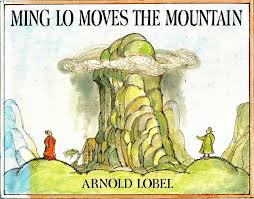 Ming Lo Moves the Mountain by Arnold Lobel. (1993, Turtleback. ISBN 9780808532101.) Picture Book. 32 pages. Gr PreK-3.
Ming Lo Moves the Mountain by Arnold Lobel. (1993, Turtleback. ISBN 9780808532101.) Picture Book. 32 pages. Gr PreK-3.
Find this book: Local Bookstore, Amazon, B&N
Lobel uses the old formula of wise man and fool for this folktale like story wherein the fool demands to know how to move a mountain. Ming Lo and his wife live in a tiny house at the foot of a large mountain. They love the house but they don't love the mountain. The wind blows down from the mountain and rocks fall from the mountain making holes in their roof. The wise man has solutions that involve dismantling his house and performing the mountain-moving dance.
 Fanny's Dream by Caralyn Buehner. Illustrated by Mark Buehner. (1996, Dial. ISBN 9780803714960.) Picture Book. 32 pages. Gr 2-6.
Fanny's Dream by Caralyn Buehner. Illustrated by Mark Buehner. (1996, Dial. ISBN 9780803714960.) Picture Book. 32 pages. Gr 2-6.
Find this book: Local Bookstore, Amazon, B&N
In Fanny's Dream we get a gentle, funny and warm story with echoes of a fairy tale. Fanny Agnes is a sturdy farm girl who dreams of marrying a prince, or at least the mayor's son. Convinced that, if it happened once, it can happen again, and ignoring the cruel taunts of her friends and relatives, Fanny waits in the garden in the moonlight for her fairy godmother to fix her up for the mayor's ball. Instead Heber, a short, kind farmer appears and asks for Fanny's hand. Read More.
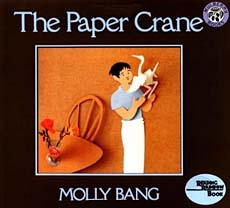 The Paper Crane by Molly Bang. (1985, Greenwillow. ISBN 9780688041083.) Picture Book. 40 pages. Gr PreK-5.
The Paper Crane by Molly Bang. (1985, Greenwillow. ISBN 9780688041083.) Picture Book. 40 pages. Gr PreK-5.
Find this book: Local Bookstore, Amazon, B&N
In this Japanese folk tale a restaurant owner's kindness to a stranger, results in the gift of a paper crane folded from a napkin. Immediately the crane comes to life, dancing when the owner claps his hands. The presence of the crane causes many customers to come to the restaurant and react with joy to the dance of the paper crane.
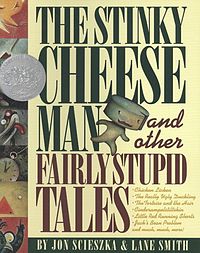 The Stinky Cheese Man: And Other Fairly Stupid Tales by Jon Scieszka. Illustrated by Lane Smith. (1992, Viking. ISBN 9780670844876.) Picture Book. 56 pages. Gr 2-9.
The Stinky Cheese Man: And Other Fairly Stupid Tales by Jon Scieszka. Illustrated by Lane Smith. (1992, Viking. ISBN 9780670844876.) Picture Book. 56 pages. Gr 2-9.
Find this book: Local Bookstore, Amazon, B&N
This humorous book of revisionist fairy tales is perfect for a diverse group of elementary school boys and girls. The ten complete stories are clever, amusing and true to their subtitle: "fairly stupid." These zany stories give students the opportunity to enjoy some modern takes on the traditional versions. There are combinations of more than one tale, new and different endings, and truly unusual twists.
 The Goose Girl by Shannon Hale. (2003, Bloomsbury. ISBN 158234843X.) Novel. 383 pages. Gr 6-9.
The Goose Girl by Shannon Hale. (2003, Bloomsbury. ISBN 158234843X.) Novel. 383 pages. Gr 6-9.
Find this book: Local Bookstore, Amazon, B&N
Hale has taken the Brothers Grimm fairy tale and given it a novel length retelling in this first of the Books of Bayern trilogy. Ani is the crown princess but is an outsider in her own family. When she is young her aunt teaches her to converse with birds, especially the swans, but her mother is mortified by the unseemly behavior of her daughter and forbids Ani any contact with birds.
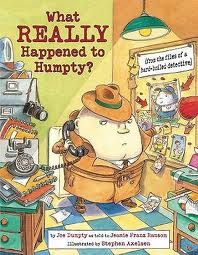 What Really Happened to Humpty?: From the Files of a Hard-Boiled Detective by Jeanie Franz Ransom. Illustrated by Stephen Axelsen. (2010, Charlesbridge. ISBN 9781580893916.) Picture Book. 40 pages. Gr PreK-3.
What Really Happened to Humpty?: From the Files of a Hard-Boiled Detective by Jeanie Franz Ransom. Illustrated by Stephen Axelsen. (2010, Charlesbridge. ISBN 9781580893916.) Picture Book. 40 pages. Gr PreK-3.
Find this book: Local Bookstore, Amazon, B&N
We all know Humpty Dumpty had a great fall but along comes his brother, Joe Dumpty, a detective (complete with trench coat and fedora), to find out what really happened. Did he fall, or was he pushed? This spoof of film noir detective stories features Mother Goose characters such as Goldilocks, Bo Peep and the Big Bad Wolf. The complicated tale is also loaded with word-play. A fun exploration of one type of detective story and a great way to play with nursery rhyme stories. For students who may not have had a lot of exposure to nursery rhymes before entering school here's an excuse to revisit them.
 Rumpelstiltskin's Daughter by Diane Stanley. (1997, HarperCollins. ISBN 9780688143282.) Picture Book. 32 pages. Gr 1-5.
Rumpelstiltskin's Daughter by Diane Stanley. (1997, HarperCollins. ISBN 9780688143282.) Picture Book. 32 pages. Gr 1-5.
Find this book: Local Bookstore, Amazon, B&N
There's a new ending for Rumpelstiltskin. Rumpelstiltskin's pleas for the miller's daughter's first child include a promise that he'll read to it and even coach Little League. She and Rumpelstiltskin escape and marry the next day. Now it's sixteen years later and their daughter Hope runs afoul of the greedy king and he sets her to spinning gold. This time Hope escapes with no hero to rescue her.
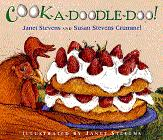 Cook-a-Doodle-Doo by Janet Stevens. Illustrated by Janet Stevens. (1999, Harcourt. ISBN 9780152022402.) Picture Book. 48 pages. Gr K-3.
Cook-a-Doodle-Doo by Janet Stevens. Illustrated by Janet Stevens. (1999, Harcourt. ISBN 9780152022402.) Picture Book. 48 pages. Gr K-3.
Find this book: Local Bookstore, Amazon, B&N
A descendant of The Little Red Hen, a fine rooster, finds her cookbook. It turns out she made much more than bread. Scorned by some of the animals, he is aided by three others, a pig, a turtle and an iguana, as the rooster attempts to make shortcake using The Little Red Hen's recipe. The process is funny and involves many "Amelia Bedelia" sorts of misunderstandings and misinterpretations and one outright disaster, but they end up with delicious shortcake.
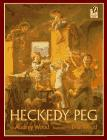 Heckedy Peg by Audrey Wood. Illustrated by Don Wood. (1992, Sandpiper. ISBN 9780152336790.) Picture Book. 32 pages. Gr 1-4.
Heckedy Peg by Audrey Wood. Illustrated by Don Wood. (1992, Sandpiper. ISBN 9780152336790.) Picture Book. 32 pages. Gr 1-4.
Find this book: Local Bookstore, Amazon, B&N
In this modern, composed fairy tale, a mother names her seven children for the days of the week. Although they are poor, the mother allows each child to request something special from the market. After extracting a promise that they will not let anyone in, the mother leaves them alone. Soon Heckedy Peg, a crafty witch, demands entrance. When she finally tricks them into admitting her, she transforms them into food and carries them off.
 Sleeping Ugly by Jane Yolen. Illustrated by Diane Stanley. (1997, Turtleback. ISBN 9780808585442.) Picture Book. 64 pages. Gr 1-9.
Sleeping Ugly by Jane Yolen. Illustrated by Diane Stanley. (1997, Turtleback. ISBN 9780808585442.) Picture Book. 64 pages. Gr 1-9.
Find this book: Local Bookstore, Amazon, B&N
This turn-about version of Sleeping Beauty gives us word play as well as a feminist twist. We have the Princess Miserella as the selfish but beautiful princess and Plain Jane as her opposite. There's the prerequisite Good Fairy and a prince, of course. The moral is clear and "punful."
Ella Enchanted by Gail Carson Levine. (1997, HarperCollins. ISBN 9780060275105.) Novel. 240 pages. Gr 3-6.
Find this book: Local Bookstore, Amazon, B&N
Levine's inspired plot has Ella cursed at birth by a well-meaning fairy who declares that she shall be obedient. This allows her, later, to become subservient to her step-sisters and step-mother. The absent or ineffective father in this novel becomes a selfish, profit hungry man whose only use for his daughter is to marry her off to wealth. Most children, hearing or reading the book, may not become aware of the Cinderella plot until well into it. This one is fun.
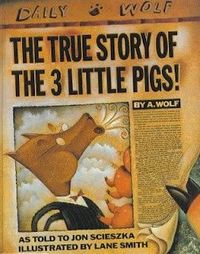 The True Story of the 3 Little Pigs by A. Wolf by Jon Scieszka. Illustrated by Lane Smith. (1989, Viking. ISBN 9780670827596.) Picture Book. 32 pages. Gr 2-9.
The True Story of the 3 Little Pigs by A. Wolf by Jon Scieszka. Illustrated by Lane Smith. (1989, Viking. ISBN 9780670827596.) Picture Book. 32 pages. Gr 2-9.
Find this book: Local Bookstore, Amazon, B&N
He was only trying to borrow a cup of sugar from his neighbors who happened to have built very flimsy houses. Not his fault! And all that huffing and puffing business? He had a cold. Could he help it that he sneezed too hard? Once the pigs were just lying there defenseless he’d be a poor excuse for a wolf for not taking advantage of the situation.
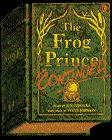 The Frog Prince, Continued by Jon Scieszka. Illustrated by Steve Johnson. (1991, Viking. ISBN 9780670834211.) Picture Book. 32 pages. Gr 2-5.
The Frog Prince, Continued by Jon Scieszka. Illustrated by Steve Johnson. (1991, Viking. ISBN 9780670834211.) Picture Book. 32 pages. Gr 2-5.
Find this book: Local Bookstore, Amazon, B&N
This is a true fairy tale extension in that we find out what happens after the princess marries the frog she kissed and turned into a prince. They didn't live happily ever after. He kept too many of his froggy ways to suit the fastidious princess. He thinks she nags too much. There is a solution, however.
The Cowboy and the Black-eyed Pea by Tony Johnston. Illustrated by Warren Ludwig. (1996, Turtleback. ISBN 9780613236003.) Picture Book. 32 pages. Gr K-4.
Find this book: Local Bookstore, Amazon, B&N
In this delightful switch on "The Princess and the Pea" it's the bodacious and wealthy Farethee Well who is looking for a sensitive mate. Knowing that a true cowboy is "known for his sensitivity", she places a black-eyed pea beneath the saddle blanket of each suitor and sends him off to ride the range.
Jim and the Beanstalk by Raymond Briggs. (1997, Perfection Learning. ISBN 9780812476514.) Picture Book. 40 pages. Gr 1-3.
Find this book: Local Bookstore, Amazon, B&N
Jack's son revisits the giant at the top of the beanstalk to find that he has aged considerably and needs lots of help. This fairy tale extension may lead to some sequels of other fairy and folk tales.
Jolly Postman by Janet & Allan Ahlberg. (2001, LB Kids. ISBN 9780316126441.) Picture Book. 32 pages. Gr 1-3.
Find this book: Local Bookstore, Amazon, B&N
A postman goes on his rounds delivering mail to the characters from fairy tales. The pages become envelopes or pockets in which the letters, junk mail and postcards can be found. Besides offering an amusing look at a large variety of mail, the book serves as a reminder of the tales from which the characters come.
Snow White in New York by Fiona French. (1986, Oxford. ISBN 9780192722102.) Picture Book. 32 pages. Gr 1-5.
Find this book: Local Bookstore, Amazon, B&N
This is a tongue in cheek version of Snow White done with Art Deco illustrations.
Search for Delicious by Natalie Babbitt. (2007, Square Fish. ISBN 9780312369828.) Novel. 192 pages. Gr 4-8.
Find this book: Local Bookstore, Amazon, B&N
At the King's request, Prime Minister DeCree is constructing a dictionary of important words. Disagreement breaks out in the court when he gets to the word delicious. The King dispatches Vaungaylen, DeCree's son, to take a poll of the entire kingdom as to the proper meaning of delicious. Vaungalen finds discord everywhere as Hemlock, the Queen's brother, has been sowing seeds of discontent.
Birthday Ball by Lois Lowry. Illustrated by Jules Feiffer. (2010, Houghton Mifflin. ISBN 9780547238692.) Novel. 192 pages. Gr 3-6.
Find this book: Local Bookstore, Amazon, B&N
Princess Patricia Priscilla is having a ball thrown for her to find a suitable suitor. She, however, has other ideas. Disguising herself as a someone from the lower classes she arrives at the local school introducing herself as the new kid which allows her to experience life in a far more down to earth way.
Classroom Activities
Compare different versions of Mother Goose (two are listed above).
- Decide which ones are best for which ages.
- Which rhymes are included, which left out. Why do you think this happens?
Find out about the real Mother Goose.
Choose one Mother Goose Rhyme. Use a thesaurus and dictionary to translate most words in the rhyme to a harder word that means the same thing: “Miniscule John Horner Seated himself at the junction of two opposing walls, Ingesting a yule tide pastry. He inserted his opposable digit, Withdrew a purple fruit, And exclaimed, “What an estimable young human being am I.”
Mother Goose is often criticized for being too violent. Find all the violence in one volume. Read about the effects on children of violence in different types of media. Older students can look up research studies on this.
Have a trial for the criminals in Mother Goose.
Write newspaper accounts of the stories in Mother Goose.
Do a television interview of one of the characters. Why did he or she do it?
Find and compare tales with the following themes or motifs:
Theft of a magic object
Helpful characters with super powers
Circle stories
Find and compare as many versions of Cinderella as possible. Remember that every civilization has at least one Cinderella story. The Cornish version is “Tattercoats”; one Native American version is “Little Burnt Face”. Decide what makes them Cinderella stories. Are there common themes?
Trace one tale other than Cinderella through as many versions as possible and guess which was the earliest version.
Make a fairy tale museum displaying Cinderella’s slipper, Snow White’s apple, etc.
Read all the tales you can which come from the area of the world most or some of your ancestors came from. Retell the best one.
Make a chart such as the one below to record the fairy tales you read:
| Name of tale | ...................................... |
| Version | ...................................... |
| Country of Origin | ...................................... |
| Hero/Heroine | ...................................... |
| Villain | ...................................... |
| First Line | ...................................... |
| Last Line | ...................................... |
| Feats or Tasks | ...................................... |
| Country of Origin | ...................................... |
Carefully examine some of the fairy tale books listed above as well as several other versions of well-known fairy tales. As you read, jot down things that the tales seem to have in common. Jot down the phrases with which they begin and end. After you’ve read five or more fairy tales, look through the list of things they have in common. What do you think makes a fairy tale a fairy tale? Discuss these lists with others in the class. Add any new thoughts to your list.
Read some of the books in the second list above that are take-offs on familiar folk and fairy tales. The True Story of the 3 Pigs, for instance, tells the story from a different point of view. As you read each book, notice how the author did it. Also notice the illustrations (if any) and the part they play in the humor of the twisted tale. How much of the original fairy tale is left in the new version?
Jot down some ideas that you could use for your own take off on a different fairy tale. Look again at some fairy tale books listed below. Try out a few beginning and ending phrases for your twisted tale. Remember the elements you decided most fairy tales had in common. How will you make your story funny? What will readers have to know in order to understand your story? What will you have to know in order to write it? Brainstorm with a friend and add to both lists. Write your story.
Make a flow chart with nine spaces for the action of one of these stories. Make the climax of the story appear in the fifth space. Do the same thing with four other fairy tales. Do they fit this pattern easily?
In several of the books listed above, one of the characters is a stepmother. Decide which issues the stepmother faces in those stories. Then find a stepmother who is willing to be interviewed about her own role. Were any of her issues like those in the books? Which of the books listed above do you think is the least realistic? Which is the most realistic?
Notice how many times the number three has significance in these tales. Often there are three characters who each try to get or achieve something. Many times the hero or heroine gets three chances to achieve it.
Related Areas of Carol Hurst's Children's Literature Site
-
Tongue-in-Cheek Versions of Folk Tales
http://www.carolhurst.com/subjects/fairytongueincheek.html
That's it for this issue.
Happy reading!
- Rebecca Otis
You can read back issues of this newsletter in our archives at:
http://www.carolhurst.com/newsletters/newsletters.html
![]()
Please visit our advertisers who make this newsletter possible:
![]()
|
|
Advertisement:
Advertisement:
Advertisement:
